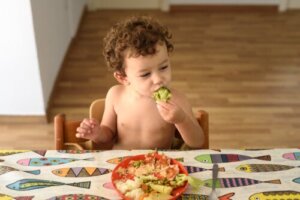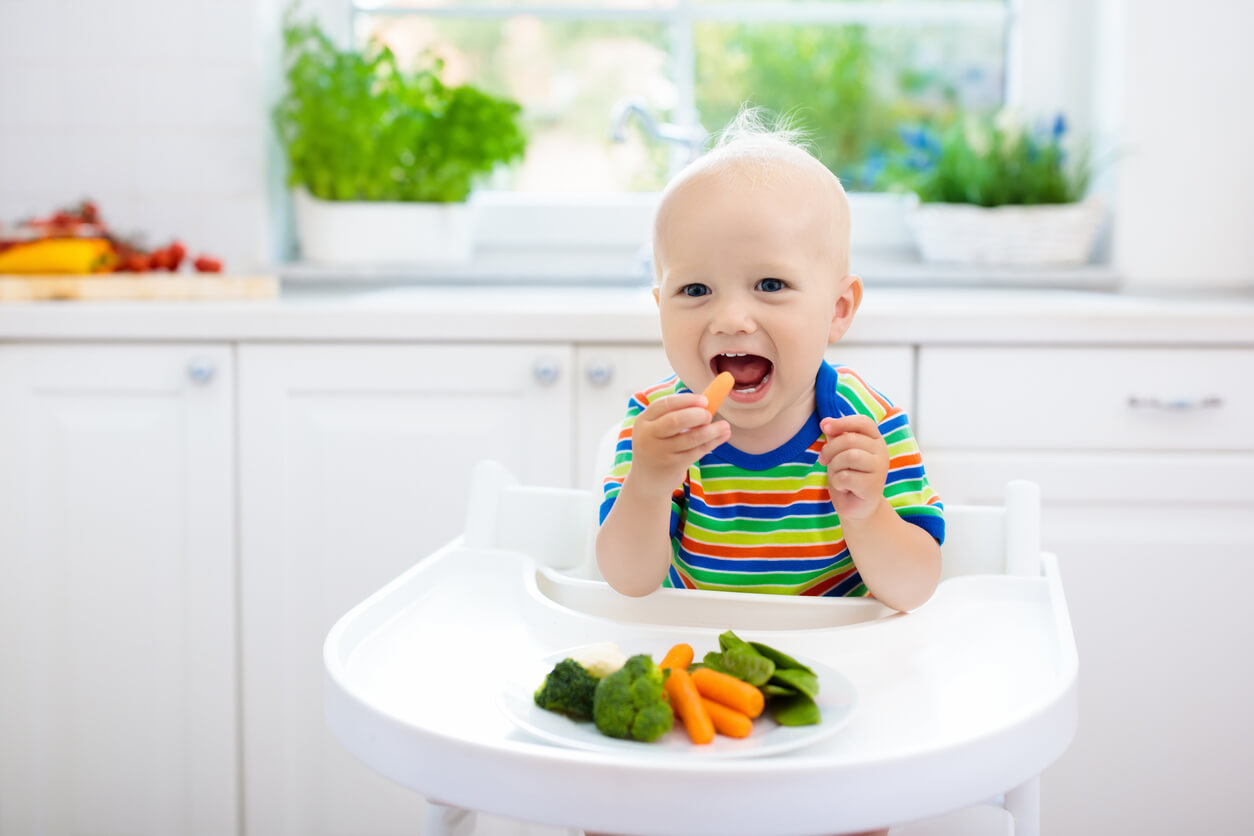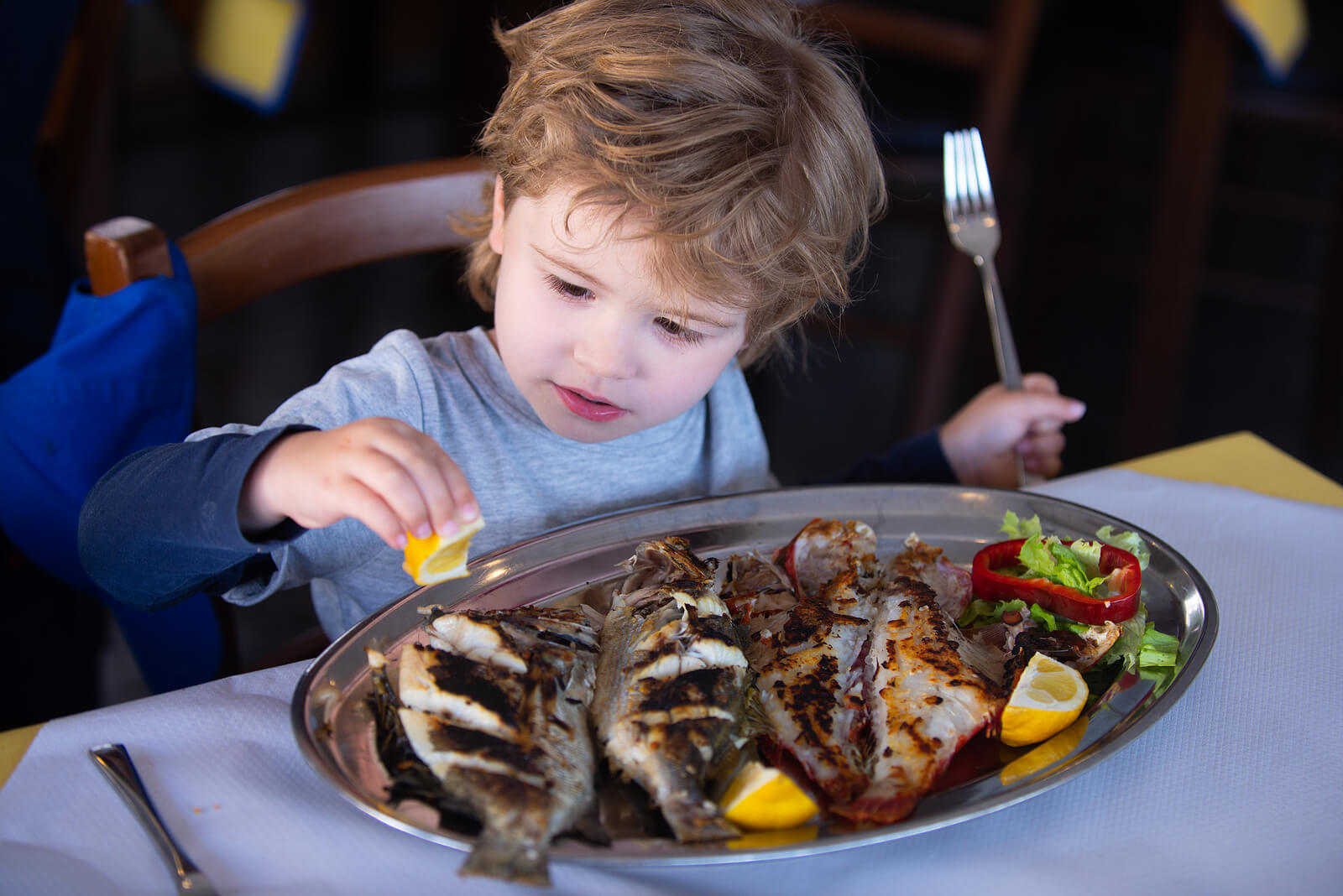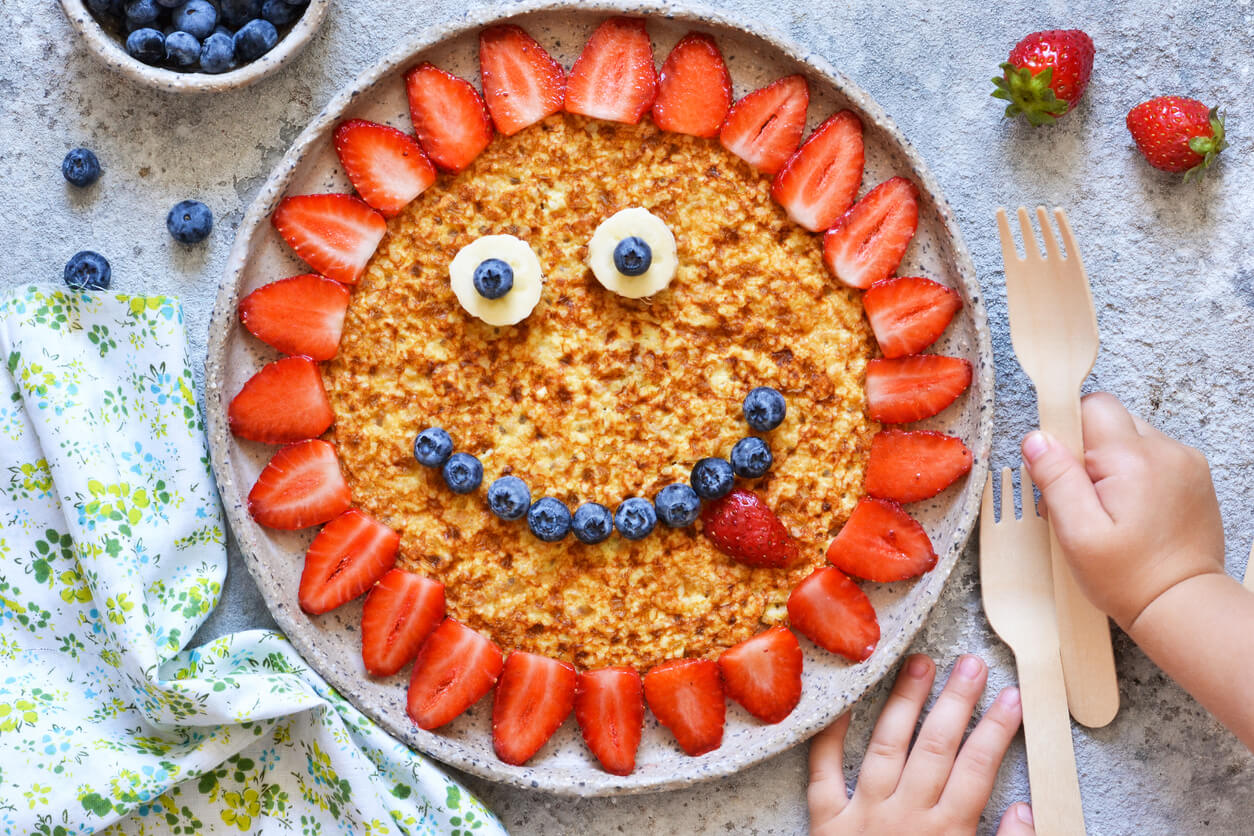13 Simple Recipes that Babies Can Eat With Their Hands

Preparing simple, finger food recipes is essential to help your baby become more familiar with different foods. this way, they increase their repertoire of textures and flavors, which helps to reduce future rejection of certain foods. Therefore, don’t miss this list of great recipe ideas that babies can eat with their hands.
Before starting, it should be noted that all these preparations offer a good nutritional intake, but it’s key to combine them to ensure a variety of vitamins, minerals, and other essential elements. In this way, you will avoid deficiencies in this important stage of growth and development of children.
To make your task easier, we have classified the preparations that babies can eat with their hands according to their main ingredients. Take note and let’s get cooking!

Recipes that babies can eat with their hands
1. Broccoli meatballs
Ingredients
- 18 ounces of broccoli
- 7 ounces of bread crumbs
- Half an onion
- Parsley
- 2 ounces of cheese
- 2 eggs
Step by step instructions
- Cook the broccoli in a pot of boiling water for 5 minutes.
- Then, drain and chop it together with the parsley, onion, and cheese.
- Place the ingredients in a bowl and add two eggs and the breadcrumbs.
- Season and stir, as long as the baby is over one year old.
- Shape the meatballs by hand and place them on a baking sheet.
- Cook for 30 minutes at 180 degrees.
2. Pumpkin and oatmeal pancakes that babies can eat with their hands
Ingredients
- 3.5 ounces of pumpkin
- 1 tablespoon of oat flour
- Spices
- Salt and baking soda (only for over 1 year old)
- Olive oil
Step by step instructions
- Prepare the pumpkin in the microwave and then peel it.
- Open it in half, remove the seeds and cut it into cubes, so that it cooks properly.
- Once it’s tender, mash it, and place it in a bowl.
- Add the oat flour, spices to taste, salt, and baking soda.
- Whisk again and brown portions of the mixture on a griddle with extra virgin olive oil.
3. Vegetable omelet
Ingredients
- Half an onion
- 1 eggplant
- 1 bell pepper
- 3 eggs
- Salt (only for babies over one year old)
Step by step instructions
- Chop the onion, eggplant, and bell pepper. Sauté them in a frying pan until tender.
- At the same time, crack 2 or 3 eggs in a bowl and beat them.
- Add the drained and cooked vegetables to the eggs, stir well, and add salt as necessary.
- Pour the mixture back into the pan to brown for a couple of minutes on each side.
4. Pasta with vegetables
Ingredients
- 1 eggplant
- 1 zucchini
- 1 bell pepper
- Salt (only for children over one year old)
- 1 tomato
- Fresh basil
- 2 ounces of Parmesan cheese
Step by step instructions
- Start by cutting the eggplant, zucchini, and bell pepper into cubes.
- Then sauté the vegetables until tender and add some salt.
- Return the vegetables to the pan and add the peeled and chopped tomato. After a few minutes, you’ll have a smooth sauce.
- To continue, cook the pasta according to the manufacturer’s instructions in a separate pot.
- Drain the pasta when ready and add it to the sauce.
- Finish with fresh basil and grated Parmesan.
Why include recipes with vegetables and legumes in your baby’s diet?
The regular presence of vegetables in a baby’s diet is essential for a good supply of antioxidants. These elements neutralize the formation of free radicals and their subsequent accumulation in the tissues. As a result, the functioning of the organism is optimized and the risk of developing chronic and complex diseases in the future is reduced.
You may be interested in: How to Start Giving Food to Your Baby Without Mashing It?

5. Salmon Burgers
Ingredients
- 12 ounces of salmon
- 1 garlic clove
- 1 onion
- 2 celery
- 2 peppers
- A teaspoon of mustard
- A tablespoon of cream cheese or yogurt
- Parsley
- Bread crumbs
- 1 egg
Step by step instructions
- Chop the garlic, onion, celery, and peppers into very small cubes.
- Season a piece of salmon with salt and pepper and grill it for 5 minutes on each side.
- Flake the fish meat and set aside.
- Sauté the vegetables and add a little mustard. Season again with salt and pepper and when the vegetables are tender. Remove from heat.
- Place the salmon in a bowl and add some cream cheese or yogurt and parsley.
- Then add the vegetables and bread crumbs.
- Now, add the beaten eggs and form the hamburgers by hand.
- Place them in a baking dish and bake them in the oven at 200 degrees for 12 minutes.
6. Baked tilapia that babies can eat with their hands
Ingredients
- Half a kilo of hake
- 7 ounces of potatoes
- 1 onion
- 1 bell pepper
- 4 cloves of garlic
- Salt (for babies over one year old)
Step by step instructions
- Wash and peel the potatoes and then cut them into sticks.
- Chop the onion into slices and the bell pepper into chunks.
- Preheat the oven to 180 degrees and place the vegetables in a dish. Then, cook them in the oven for 25 minutes.
- After this time, place the pieces of fish with salt and pepper on top of the potatoes and put the dish back in the oven for 20 more minutes.
- To finish, sauté garlic in a frying pan and pour it on top of the preparation.
7. Salmon en papillote
Ingredients
- Seasonal vegetables
- Salmon
- Olive oil
Step by step instructions
- First, cut the vegetables to taste, preferably into sticks.
- Then place them in the bottom of a silicone baking dish. Pour a drizzle of olive oil and a little water on top.
- Put the salmon covering the vegetables and close the container.
- Bake in the oven at 200 degrees for 15 minutes and it’s ready.
8. Baked sea bass
Ingredients
- 1 sea bass
- 1 potato
- One onion
- Olive oil
- Salt (if the baby is older than one year old)
Step by step instructions
- To begin, cut the potatoes with a mandolin and chop the onion into julienne strips.
- Arrange both ingredients in the bottom of a baking tray with a little salt and olive oil.
- Bake them for 15 minutes at 325 degrees.
- After the time, season the fish with salt and pepper (already prepared for the oven by the fishmonger) and place it on top of the potatoes.
- Bake for 20 minutes more and it’s ready.
Why include these fish recipes in your baby’s diet?
Fish is a fundamental food in the diet because it’s an optimal source of omega-3 fatty acids. These elements have been shown to be able to regulate inflammation in various organs and tissues and reduce the risk of developing complex diseases in the future. In addition, they contribute to the good muscular health of infants.

9. Veal stew
Ingredients
- 2 pounds of beef
- 2 carrots
- 1 onion
- 4 cups of chicken broth
- Mustard and salt (babies over one year old).
Step by step
- Peel and cut the carrots and onions.
- Then, brown them in a frying pan.
- Then add the meat. When the meat is sealed, add a little mustard and black pepper.
- At this point, cover with chicken broth and let it cook for a couple of hours at a very low temperature.
- When the sauce has thickened a little, more water can be added as desired.
10. Roast veal round
Ingredients
- Beef
- Onion
- Olive oil and pepper
- White wine
- Thyme and bay leaf
- Garlic
Step by step instructions
- Remove the fat from the meat and then tie it with a string. It’s best to marinate it overnight, but this step can be omitted.
- To start cooking, cut the onion into large pieces and place them in an oven tray.
- Arrange the seasoned meat on top and bathe it with olive oil and white wine.
- Sprinkle thyme and bay leaf with 2 garlic.
- Add a little water and cook at 350 degrees for one hour.
Why incorporate these recipes with meat into your baby’s diet?
Meat from land animals (chicken, pork, beef) is an essential component in the infant diet because it provides iron, vitamin B12, and proteins of high biological value. These last elements assure correct growth and structural development and also constitute an adequate source of energy.

11. Oatmeal cookies
Ingredients
- 12 ounces of pumpkin
- 1 cup of oat flakes
- 4 eggs
- 5 chopped walnuts
- Cinnamon and vanilla essence
Step by step instructions
- Roast a pumpkin in the oven.
- In the meantime, mix the oat flakes and eggs.
- Then, add the pumpkin and beat everything well. Split the walnuts and add them as well.
- Then add a little cinnamon and vanilla essence.
- Fill cookie tins with the mixture and bake at 325 degrees for 30 minutes.
12. Apple omelet
Ingredients
- 2 apples
- 5 tablespoons of butter
- Cinnamon
- 2 tablespoons of sugar (over 1 year old)
- 2 eggs
Step by step instructions
- First wash, peel, and slice the apples.
- Cook them over medium heat with butter and cinnamon.
- When they’re soft, add the sugar and continue cooking for 2 more minutes.
- Finish by beating the eggs and adding the apple, then brown the mixture in the pan again for a couple of minutes.
13. Sponge cake
Ingredients
- 8 tablespoons (1 stick) of butter
- 1 cup of sugar (for babies over one year old)
- 4 eggs
- Vanilla essence
- Juice of one lemon
- 1 1/2 cups of flour
- 3 teaspoons of yeast
- Salt
- Lemon zest
Step by step instructions
- Beat the butter and sugar in a bowl.
- Then add the eggs one at a time and continue mixing.
- Pour in the vanilla essence along with the lemon juice.
- Separately, mix the flour, yeast, salt, and lemon zest.
- Just after, put the two mixtures together and stir everything.
- Transfer the preparation to a baking dish and bake it for 45 minutes at 180 degrees.
Prepare simple recipes that babies can eat with their hands
As you’ve seen, there are many alternatives for preparing simple recipes that babies can eat with their hands and thus improve their nutrient intake. In the case of fish-based recipes, it’s important to remove all the bones before preparing them in order to avoid accidents.
Finally, remember that to safeguard the good health of the little ones, it’s essential to provide them with a varied and balanced diet from the very beginning. This will ensure an optimal supply of essential nutrients.
Preparing simple, finger food recipes is essential to help your baby become more familiar with different foods. this way, they increase their repertoire of textures and flavors, which helps to reduce future rejection of certain foods. Therefore, don’t miss this list of great recipe ideas that babies can eat with their hands.
Before starting, it should be noted that all these preparations offer a good nutritional intake, but it’s key to combine them to ensure a variety of vitamins, minerals, and other essential elements. In this way, you will avoid deficiencies in this important stage of growth and development of children.
To make your task easier, we have classified the preparations that babies can eat with their hands according to their main ingredients. Take note and let’s get cooking!

Recipes that babies can eat with their hands
1. Broccoli meatballs
Ingredients
- 18 ounces of broccoli
- 7 ounces of bread crumbs
- Half an onion
- Parsley
- 2 ounces of cheese
- 2 eggs
Step by step instructions
- Cook the broccoli in a pot of boiling water for 5 minutes.
- Then, drain and chop it together with the parsley, onion, and cheese.
- Place the ingredients in a bowl and add two eggs and the breadcrumbs.
- Season and stir, as long as the baby is over one year old.
- Shape the meatballs by hand and place them on a baking sheet.
- Cook for 30 minutes at 180 degrees.
2. Pumpkin and oatmeal pancakes that babies can eat with their hands
Ingredients
- 3.5 ounces of pumpkin
- 1 tablespoon of oat flour
- Spices
- Salt and baking soda (only for over 1 year old)
- Olive oil
Step by step instructions
- Prepare the pumpkin in the microwave and then peel it.
- Open it in half, remove the seeds and cut it into cubes, so that it cooks properly.
- Once it’s tender, mash it, and place it in a bowl.
- Add the oat flour, spices to taste, salt, and baking soda.
- Whisk again and brown portions of the mixture on a griddle with extra virgin olive oil.
3. Vegetable omelet
Ingredients
- Half an onion
- 1 eggplant
- 1 bell pepper
- 3 eggs
- Salt (only for babies over one year old)
Step by step instructions
- Chop the onion, eggplant, and bell pepper. Sauté them in a frying pan until tender.
- At the same time, crack 2 or 3 eggs in a bowl and beat them.
- Add the drained and cooked vegetables to the eggs, stir well, and add salt as necessary.
- Pour the mixture back into the pan to brown for a couple of minutes on each side.
4. Pasta with vegetables
Ingredients
- 1 eggplant
- 1 zucchini
- 1 bell pepper
- Salt (only for children over one year old)
- 1 tomato
- Fresh basil
- 2 ounces of Parmesan cheese
Step by step instructions
- Start by cutting the eggplant, zucchini, and bell pepper into cubes.
- Then sauté the vegetables until tender and add some salt.
- Return the vegetables to the pan and add the peeled and chopped tomato. After a few minutes, you’ll have a smooth sauce.
- To continue, cook the pasta according to the manufacturer’s instructions in a separate pot.
- Drain the pasta when ready and add it to the sauce.
- Finish with fresh basil and grated Parmesan.
Why include recipes with vegetables and legumes in your baby’s diet?
The regular presence of vegetables in a baby’s diet is essential for a good supply of antioxidants. These elements neutralize the formation of free radicals and their subsequent accumulation in the tissues. As a result, the functioning of the organism is optimized and the risk of developing chronic and complex diseases in the future is reduced.
You may be interested in: How to Start Giving Food to Your Baby Without Mashing It?

5. Salmon Burgers
Ingredients
- 12 ounces of salmon
- 1 garlic clove
- 1 onion
- 2 celery
- 2 peppers
- A teaspoon of mustard
- A tablespoon of cream cheese or yogurt
- Parsley
- Bread crumbs
- 1 egg
Step by step instructions
- Chop the garlic, onion, celery, and peppers into very small cubes.
- Season a piece of salmon with salt and pepper and grill it for 5 minutes on each side.
- Flake the fish meat and set aside.
- Sauté the vegetables and add a little mustard. Season again with salt and pepper and when the vegetables are tender. Remove from heat.
- Place the salmon in a bowl and add some cream cheese or yogurt and parsley.
- Then add the vegetables and bread crumbs.
- Now, add the beaten eggs and form the hamburgers by hand.
- Place them in a baking dish and bake them in the oven at 200 degrees for 12 minutes.
6. Baked tilapia that babies can eat with their hands
Ingredients
- Half a kilo of hake
- 7 ounces of potatoes
- 1 onion
- 1 bell pepper
- 4 cloves of garlic
- Salt (for babies over one year old)
Step by step instructions
- Wash and peel the potatoes and then cut them into sticks.
- Chop the onion into slices and the bell pepper into chunks.
- Preheat the oven to 180 degrees and place the vegetables in a dish. Then, cook them in the oven for 25 minutes.
- After this time, place the pieces of fish with salt and pepper on top of the potatoes and put the dish back in the oven for 20 more minutes.
- To finish, sauté garlic in a frying pan and pour it on top of the preparation.
7. Salmon en papillote
Ingredients
- Seasonal vegetables
- Salmon
- Olive oil
Step by step instructions
- First, cut the vegetables to taste, preferably into sticks.
- Then place them in the bottom of a silicone baking dish. Pour a drizzle of olive oil and a little water on top.
- Put the salmon covering the vegetables and close the container.
- Bake in the oven at 200 degrees for 15 minutes and it’s ready.
8. Baked sea bass
Ingredients
- 1 sea bass
- 1 potato
- One onion
- Olive oil
- Salt (if the baby is older than one year old)
Step by step instructions
- To begin, cut the potatoes with a mandolin and chop the onion into julienne strips.
- Arrange both ingredients in the bottom of a baking tray with a little salt and olive oil.
- Bake them for 15 minutes at 325 degrees.
- After the time, season the fish with salt and pepper (already prepared for the oven by the fishmonger) and place it on top of the potatoes.
- Bake for 20 minutes more and it’s ready.
Why include these fish recipes in your baby’s diet?
Fish is a fundamental food in the diet because it’s an optimal source of omega-3 fatty acids. These elements have been shown to be able to regulate inflammation in various organs and tissues and reduce the risk of developing complex diseases in the future. In addition, they contribute to the good muscular health of infants.

9. Veal stew
Ingredients
- 2 pounds of beef
- 2 carrots
- 1 onion
- 4 cups of chicken broth
- Mustard and salt (babies over one year old).
Step by step
- Peel and cut the carrots and onions.
- Then, brown them in a frying pan.
- Then add the meat. When the meat is sealed, add a little mustard and black pepper.
- At this point, cover with chicken broth and let it cook for a couple of hours at a very low temperature.
- When the sauce has thickened a little, more water can be added as desired.
10. Roast veal round
Ingredients
- Beef
- Onion
- Olive oil and pepper
- White wine
- Thyme and bay leaf
- Garlic
Step by step instructions
- Remove the fat from the meat and then tie it with a string. It’s best to marinate it overnight, but this step can be omitted.
- To start cooking, cut the onion into large pieces and place them in an oven tray.
- Arrange the seasoned meat on top and bathe it with olive oil and white wine.
- Sprinkle thyme and bay leaf with 2 garlic.
- Add a little water and cook at 350 degrees for one hour.
Why incorporate these recipes with meat into your baby’s diet?
Meat from land animals (chicken, pork, beef) is an essential component in the infant diet because it provides iron, vitamin B12, and proteins of high biological value. These last elements assure correct growth and structural development and also constitute an adequate source of energy.

11. Oatmeal cookies
Ingredients
- 12 ounces of pumpkin
- 1 cup of oat flakes
- 4 eggs
- 5 chopped walnuts
- Cinnamon and vanilla essence
Step by step instructions
- Roast a pumpkin in the oven.
- In the meantime, mix the oat flakes and eggs.
- Then, add the pumpkin and beat everything well. Split the walnuts and add them as well.
- Then add a little cinnamon and vanilla essence.
- Fill cookie tins with the mixture and bake at 325 degrees for 30 minutes.
12. Apple omelet
Ingredients
- 2 apples
- 5 tablespoons of butter
- Cinnamon
- 2 tablespoons of sugar (over 1 year old)
- 2 eggs
Step by step instructions
- First wash, peel, and slice the apples.
- Cook them over medium heat with butter and cinnamon.
- When they’re soft, add the sugar and continue cooking for 2 more minutes.
- Finish by beating the eggs and adding the apple, then brown the mixture in the pan again for a couple of minutes.
13. Sponge cake
Ingredients
- 8 tablespoons (1 stick) of butter
- 1 cup of sugar (for babies over one year old)
- 4 eggs
- Vanilla essence
- Juice of one lemon
- 1 1/2 cups of flour
- 3 teaspoons of yeast
- Salt
- Lemon zest
Step by step instructions
- Beat the butter and sugar in a bowl.
- Then add the eggs one at a time and continue mixing.
- Pour in the vanilla essence along with the lemon juice.
- Separately, mix the flour, yeast, salt, and lemon zest.
- Just after, put the two mixtures together and stir everything.
- Transfer the preparation to a baking dish and bake it for 45 minutes at 180 degrees.
Prepare simple recipes that babies can eat with their hands
As you’ve seen, there are many alternatives for preparing simple recipes that babies can eat with their hands and thus improve their nutrient intake. In the case of fish-based recipes, it’s important to remove all the bones before preparing them in order to avoid accidents.
Finally, remember that to safeguard the good health of the little ones, it’s essential to provide them with a varied and balanced diet from the very beginning. This will ensure an optimal supply of essential nutrients.
All cited sources were thoroughly reviewed by our team to ensure their quality, reliability, currency, and validity. The bibliography of this article was considered reliable and of academic or scientific accuracy.
- Alkadi H. (2020). A Review on Free Radicals and Antioxidants. Infectious disorders drug targets, 20(1), 16–26. https://doi.org/10.2174/1871526518666180628124323
- Calder P. C. (2017). Omega-3 fatty acids and inflammatory processes: from molecules to man. Biochemical Society transactions, 45(5), 1105–1115. https://doi.org/10.1042/BST20160474
- Comité de Lactancia Materna y Comité de Nutrición de la Asociación Española de Pediatría. (2018). RECOMENDACIONES DE LA ASOCIACIÓN ESPAÑOLA DE PEDIATRÍA SOBRE LA ALIMENTACIÓN COMPLEMENTARIA. Disponible en: https://www.aeped.es/sites/default/files/documentos/recomendaciones_aep_sobre_alimentacio_n
This text is provided for informational purposes only and does not replace consultation with a professional. If in doubt, consult your specialist.








